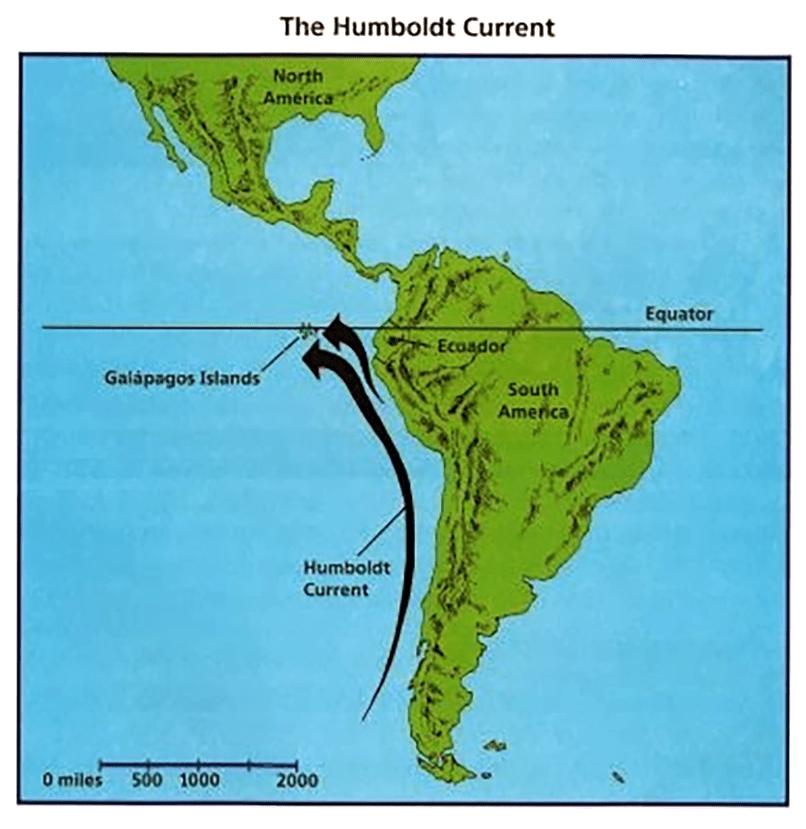
Table of Contents
Origin of Humboldt Current

Effects of the Humboldt Current
The Humboldt Current has a significant impact on the climate, weather, and marine life of the region. It helps to cool the air temperature along the coast, creating a unique desert climate known as the Atacama Desert. This current also plays a critical role in the marine ecosystem, providing nutrient-rich water to support a diverse range of marine species.

Importance to the Marine Ecosystem
The Humboldt Current is home to a rich array of marine life, including numerous species of fish, birds, and mammals. The nutrient-rich waters of the current support the growth of phytoplankton, which forms the base of the food chain for many species. The current is also an important breeding ground for several species of fish, including anchovies and sardines, which are critical for both commercial and recreational fishing.
Threats to the Humboldt Current
Despite its importance, the Humboldt Current is facing several threats, including climate change, overfishing, and pollution. Rising temperatures in the Pacific Ocean are affecting the current’s flow, causing changes in the distribution and abundance of marine species. Overfishing and pollution are also having a significant impact on the ecosystem, threatening the survival of many species that rely on the current for their survival.
Conclusion
The Humboldt Current is a powerful force of nature that has a significant impact on the climate, weather, and marine life of the western coast of South America. While it faces several threats, including climate change, overfishing, and pollution, it remains an essential component of the marine ecosystem. By understanding the origins, effects, and importance of the Humboldt Current, we can work to protect and preserve this vital resource for future generations.
Summary
- The Humboldt Current flows along the western coast of South America
- It is formed by trade winds, the Coriolis effect, and upwelling of cold, nutrient-rich water
- The current has a significant impact on climate, weather, and marine life in the region
- It supports a diverse range of marine species and is an important breeding ground for fish
- Threats to the Humboldt Current include climate change, overfishing, and pollution
- Understanding the origins, effects, and importance of the Humboldt Current is crucial for its protection and preservation
MCQ
Q. What is the Humboldt Current?
A) A river in South America
B) An ocean current that flows along the western coast of South America
C) A desert in South America
D) A mountain range in South America
Answer: B) An ocean current that flows along the western coast of South America. This is explained in the introduction section of the article.
Q. What are the factors that contribute to the formation of the Humboldt Current?
A) Tidal waves, ocean currents, and sea level changes
B) Trade winds, the Coriolis effect, and upwelling of cold, nutrient-rich water
C) Hurricanes, typhoons, and tropical storms
D) Earthquakes, volcanic eruptions, and tsunamis
Answer: B) Trade winds, the Coriolis effect, and upwelling of cold, nutrient-rich water. This is explained in the Origins of the Humboldt Current section of the article.
Q. What is the significance of the Humboldt Current to the marine ecosystem?
A) It creates a unique desert climate along the coast
B) It supports the growth of phytoplankton, which forms the base of the food chain
C) It helps to cool the air temperature along the coast
D) It is an important breeding ground for several species of fish
Answer: B) It supports the growth of phytoplankton, which forms the base of the food chain. This is explained in the Importance to the Marine Ecosystem section of the article.
Q. What are the threats facing the Humboldt Current?
A) Climate change, overfishing, and pollution
B) Tectonic plate movements, volcanic eruptions, and earthquakes
C) Hurricanes, typhoons, and tropical storms
D) Tidal waves, ocean currents, and sea level changes
Answer: A) Climate change, overfishing, and pollution. This is explained in the Threats to the Humboldt Current section of the article.
Q. What is the importance of understanding the Humboldt Current?
A) To exploit its resources for commercial purposes
B) To preserve and protect the marine ecosystem
C) To create more fishing opportunities
D) To promote tourism in the region
Answer: B) To preserve and protect the marine ecosystem. This is explained in the Conclusion section of the article.